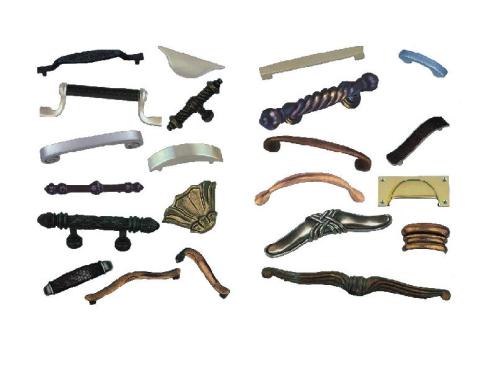 1. Collaborative Innovation in Product Development
As society continues to evolve, both domestic and international customers are demanding higher quality and more diverse furniture products. Often, the styles and functional requirements set by customers do not align with the existing hardware solutions available on the market. To meet these expectations, furniture hardware manufacturers must work closely with furniture designers and producers. This collaboration allows both parties to leverage their strengths in design, technology, and production capabilities, creating a more integrated and efficient development process.
Furniture hardware and furniture designs are now being developed in parallel, with joint testing and adjustments to ensure optimal performance and aesthetics. This approach maximizes resource utilization and ensures the best possible product configuration.
Modern digital technologies provide a solid foundation for information sharing and technical coordination in the development of new hardware products. These tools also enable faster and more precise manufacturing processes. Through this collaborative model, furniture companies can fulfill specific needs, while hardware suppliers benefit by expanding their product range and improving overall quality. This mutual growth fosters a win-win relationship between manufacturers and suppliers. In today’s competitive market, such cooperation is essential for staying ahead and delivering superior value to consumers.
2. The Fusion of Aesthetics and Functionality
Furniture hardware can be broadly categorized into decorative and functional types. However, many manufacturers tend to separate these two aspects, with decorative hardware often lacking in functionality, and functional hardware sometimes neglecting aesthetic appeal. This disconnect can lead to products that perform well but fail to enhance the visual appeal of the furniture.
Take door hardware as an example—while its functions and structures have been continuously refined over the years, its design has often been overlooked. As a result, many products work well but don’t always look good. In recent years, with the rise of innovative design thinking, more designers are beginning to view furniture hardware through the lens of industrial design. This shift emphasizes the integration of form and function, making it a key trend in the future of furniture hardware development.
3. Human-Centered Design Enhances Everyday Experience
The quality of life is increasingly influenced by small, everyday details, and furniture hardware plays a significant role in reflecting this. From the smooth opening of a cabinet door to the quiet glide of a drawer, high-quality hardware enhances the user experience. These seemingly minor actions embody the principles of human-centered design.
In the future, concepts such as safety, ease of use, noise reduction, and comfort will be more deeply embedded in the design of furniture hardware. This shift is not just a trend but a necessity driven by social progress and changing consumer expectations. As people become more conscious of their surroundings, furniture hardware will need to evolve to meet these higher standards, ensuring a more comfortable and thoughtful living environment.
1. Collaborative Innovation in Product Development
As society continues to evolve, both domestic and international customers are demanding higher quality and more diverse furniture products. Often, the styles and functional requirements set by customers do not align with the existing hardware solutions available on the market. To meet these expectations, furniture hardware manufacturers must work closely with furniture designers and producers. This collaboration allows both parties to leverage their strengths in design, technology, and production capabilities, creating a more integrated and efficient development process.
Furniture hardware and furniture designs are now being developed in parallel, with joint testing and adjustments to ensure optimal performance and aesthetics. This approach maximizes resource utilization and ensures the best possible product configuration.
Modern digital technologies provide a solid foundation for information sharing and technical coordination in the development of new hardware products. These tools also enable faster and more precise manufacturing processes. Through this collaborative model, furniture companies can fulfill specific needs, while hardware suppliers benefit by expanding their product range and improving overall quality. This mutual growth fosters a win-win relationship between manufacturers and suppliers. In today’s competitive market, such cooperation is essential for staying ahead and delivering superior value to consumers.
2. The Fusion of Aesthetics and Functionality
Furniture hardware can be broadly categorized into decorative and functional types. However, many manufacturers tend to separate these two aspects, with decorative hardware often lacking in functionality, and functional hardware sometimes neglecting aesthetic appeal. This disconnect can lead to products that perform well but fail to enhance the visual appeal of the furniture.
Take door hardware as an example—while its functions and structures have been continuously refined over the years, its design has often been overlooked. As a result, many products work well but don’t always look good. In recent years, with the rise of innovative design thinking, more designers are beginning to view furniture hardware through the lens of industrial design. This shift emphasizes the integration of form and function, making it a key trend in the future of furniture hardware development.
3. Human-Centered Design Enhances Everyday Experience
The quality of life is increasingly influenced by small, everyday details, and furniture hardware plays a significant role in reflecting this. From the smooth opening of a cabinet door to the quiet glide of a drawer, high-quality hardware enhances the user experience. These seemingly minor actions embody the principles of human-centered design.
In the future, concepts such as safety, ease of use, noise reduction, and comfort will be more deeply embedded in the design of furniture hardware. This shift is not just a trend but a necessity driven by social progress and changing consumer expectations. As people become more conscious of their surroundings, furniture hardware will need to evolve to meet these higher standards, ensuring a more comfortable and thoughtful living environment.Laser galvanometer for high speed laser scanning system, consisting of X and Y mirrors, for galvanometer /CO2 galvanometer /1064galvanometer and UV galvanometer.
Laser Vibration Mirror,High-Speed Laser Scanning,Laser Cutting Galvanometer,Laser Marking Galvanometer
Changchun Champion Optics Co.,Ltd , https://www.champion-optics.com